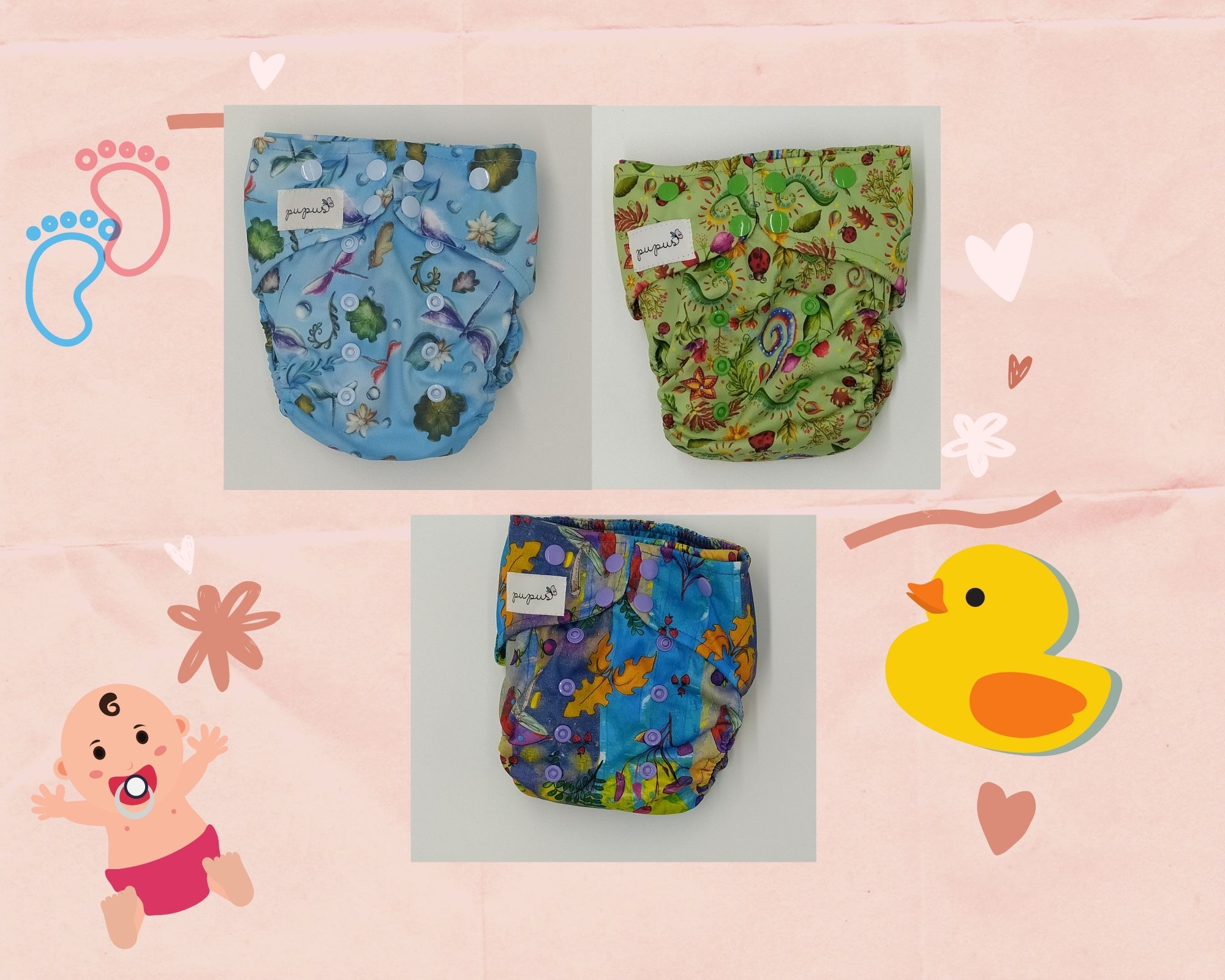Reusable diapers – what to start with for a baby?

Reusable diapers – what to start with for a baby? What should you buy to make reusable diapering comfortable and hassle-free? Is it worth investing in pocket diapers or covers?
Many mothers I talk to are afraid that reusable diapers will be too difficult for them and simply overwhelm them. However, once you start using reusable diapers, you realize that it's not very complicated and really easy to use them.
Reusable diapers – what to start with for a baby
When you have an older child (we've already written about what to buy for a newborn in the article: Reusable diapers – what to start with for a newborn) and want to switch from disposables to reusables, it's a good idea to familiarize yourself with the available range first. This will help you choose what will actually work for you.
1. Which reusable diapers and how many should you buy for your baby?
The first question you need to answer is which diapers to buy and how many. There are several types of diapers available on the market, each with their own advantages and disadvantages.
Reusable diapers – what to start with for your baby?
Pocket diapers - Personally, I would say that these are my favorite diapers. Pocket diapers consist of an outer waterproof layer (PUL or minky fabric) and an inner microfleece layer. They have a pocket – a place where you put the absorbent insert.
Pocket diapers are convenient for many reasons – they can be prepared in advance, and when changing the diaper, all you have to do is fasten it on the baby. This is a good option when leaving the baby in the care of someone else (grandmother, grandfather, babysitter, nursery). Pocket diapers are easy to use and leave no room for doubt.
The downside of pockets is that they take a little longer to dry. In addition, we need slightly more of them than wraps for a full diaper change.
If we decide to use pockets alone, we will need about 20 of them. Remember that absorbent inserts are also needed for diapers. It is worth buying more of them, as inserts usually take longer to dry than the diapers themselves.
Pocket diapers are available in a universal size. These diapers are said to “grow” with your child. This means that as your child grows, you can increase the size of the diaper to best fit your child.
A cover diaper is a diaper that consists only of a waterproof outer layer. For the wrap to work, you need to place an absorbent insert inside it. A definite advantage of the wrap is that it dries very quickly. What's more, there's no need to change the cover every time you change your baby's diaper. As long as it's not dirty or wet, you can just change the insert.
You'll need about 4 covers and 24 absorbent inserts for a full diapering system.
Covers are also diapers that grow with your child.
A molded diaper is an absorbent diaper without a waterproof layer. For it to work, it must be covered with a diaper cover. Molded diapers are great for nighttime and longer walks. They absorb more and can last longer before needing to be changed.
2. Which absorbent inserts should you invest in?
There is a huge selection of absorbent inserts available. They differ in the material they are made of, thickness, shape, absorbency, and drying time. In our article, we compared absorbent inserts (we also tested their absorbency) – it's worth reading!
You will need about 24 absorbent inserts for full diapering. Why so many? The reason is simple – inserts do not dry as quickly as diapers, so we need more of them to be able to diaper. In my opinion, it is worth stocking up on several types of inserts.
The most absorbent inserts are hemp pre-folds. It's worth having a few of them for walks, naps, or at night. Their downside is that they take a very long time to dry and become stiff after washing.
- Bamboo pre-folds are also extremely absorbent inserts. Their advantage is that they remain soft even after many washes.
- Bamboo-carbon inserts – these are our very popular inserts. They are great for everyday use. They absorb well and dry relatively quickly.
- Microfiber inserts – if you're on a tighter budget, you can invest in these inserts. Their advantage is that they dry quickly. The downside is their limited absorbency and the need for stripping from time to time.
Dry Bum inserts and liners
When using cover diapers plus inserts, there is a risk that the baby will feel damp. To prevent this, "Dry Bum" inserts are used. These inserts are a thin layer of microfiber.
For poop, we recommend using disposable corn paper or bamboo tissue paper. Once soiled, throw them in the trash.
What if I find it difficult to decide?
We recommend our Pupus starter set. The starter set includes several types of diapers and inserts. This way, you can see what works best for you.
3. How should I store dirty diapers?
Dirty diapers waiting to be washed are best stored in an airtight bucket with a lid. You can add a few drops of tea tree oil to neutralize odors and disinfect. A PUL bag is perfect for transporting dirty diapers outside the home. It is waterproof, keeps odors inside, is airtight, and has a zipper closure.
Reusable diapers can be washed in the washing machine with regular washing powder. It is worth buying a powder for disinfecting diapers and adding a small amount to each wash. I also add a tablespoon of baking soda – it bleaches – and a few drops of tea tree oil – it refreshes the diapers and also has disinfecting properties.
